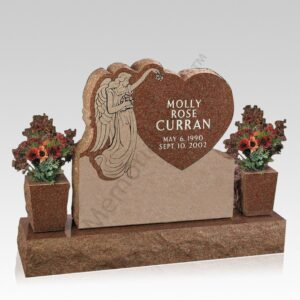A New Trend for Upright Monuments
In today’s world, the age-old upright monument seems to be becoming less and less of a common site in cemeteries. But that may be changing in the coming months. Once the staple of most any cemetery, these most elaborate of grave markers have had to make considerable room for their smaller cousins, the flat grave marker and the raised grave marker in recent years. In fact, many cemeteries across America have set aside entire sections (sometimes the entire cemetery) in which upright monuments are not allowed. It’s clear that upright markers for individual graves have become a luxury, of sorts, available mostly for those whose resources and circumstances allow.

All that said, it’s important to note that upright monuments still do remain popular enough to account for a sizeable portion of overall grave marker sales. It seems that, when price, available space and cemetery rules do not make upright monuments impractical, they are still the grave marker style of choice for most families. The problem is that, in a growing number cases each year, price, available space and cemetery rules do, in fact, simply make upright monuments impractical. (However, it is still quite common for families to erect one upright ‘family’ marker, if you will, to mark an entire plot of graves and then use simple flat markers to mark the graves of individual family members.)
But the emergence of a new type of construction material from which upright grave markers can be made just may very well bring upright memorials back to their days when they were the undisputed king of just about any cemetery. The new material made, almost magically, from crops that can grow on almost any farmer’s field, eliminates a huge amount of the labor and production costs associated with traditional upright grave markers. Through a patented process, these crops are blended into an amazingly sturdy substance that can be molded into any shape and can be configured with texture and color that look amazingly similar to granite, marble or cement. The new material can be made into upright grave markers that are as durable as any made from other materials and, as a plus, have a fraction of the weight — which makes them very easy to install. Upright monuments made from this new material cost less and can be easier to install and maintain than traditional upright monuments.
While the new material is taking the memorial market by storm, the fact remains that granite upright headstones remain the most popular choice for many. While the stone may be heavier, making it harder to install the tribute, it only goes to show that the headstone will stay put – a stalwart tribute to a life of loving memories. Some also simply like the idea of their monument being made of a compeletely natural material – and in a traditional method. Regardless of one’s choice of headstone material, upright monuments face one particular issue that has caused many cemeteries to ban (or at least partially ban) upright grave markers: cutting grass near an upright marker is still a troublesome affair, no matter what material the monument is made of. Many cemeteries have found that they can keep costs in check by simply requiring that all markers be flat, so that a lawn mower can ride over them quickly and easily each week.
While many individuals are opting to go with the flat markers, many families still fight for their right to have an upright memorial. In fact, for some families it is tradition to have an upright marker made in a certain type of stone, and following a certain design. That alone gives reason for us to continue in the tradition of honoring our lost loved ones through any means appropriate – including the use of upright headstones.
